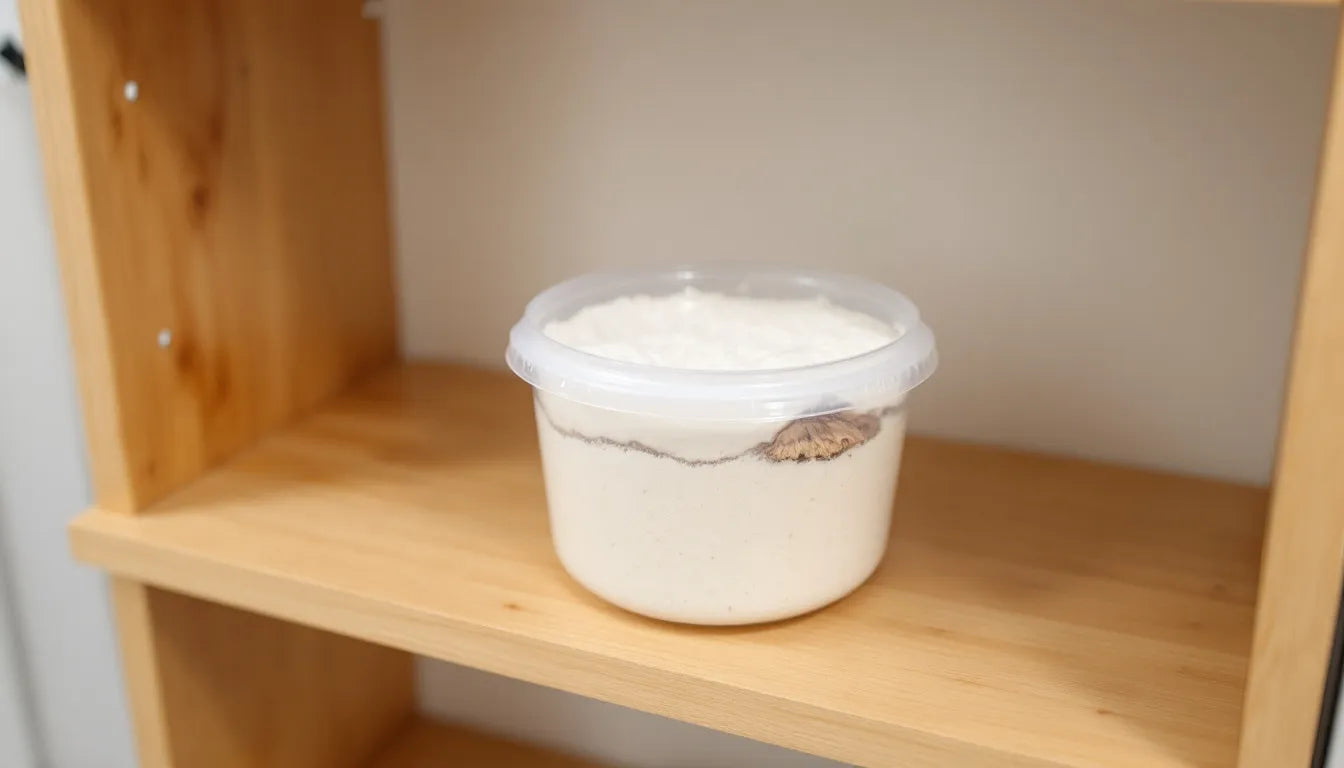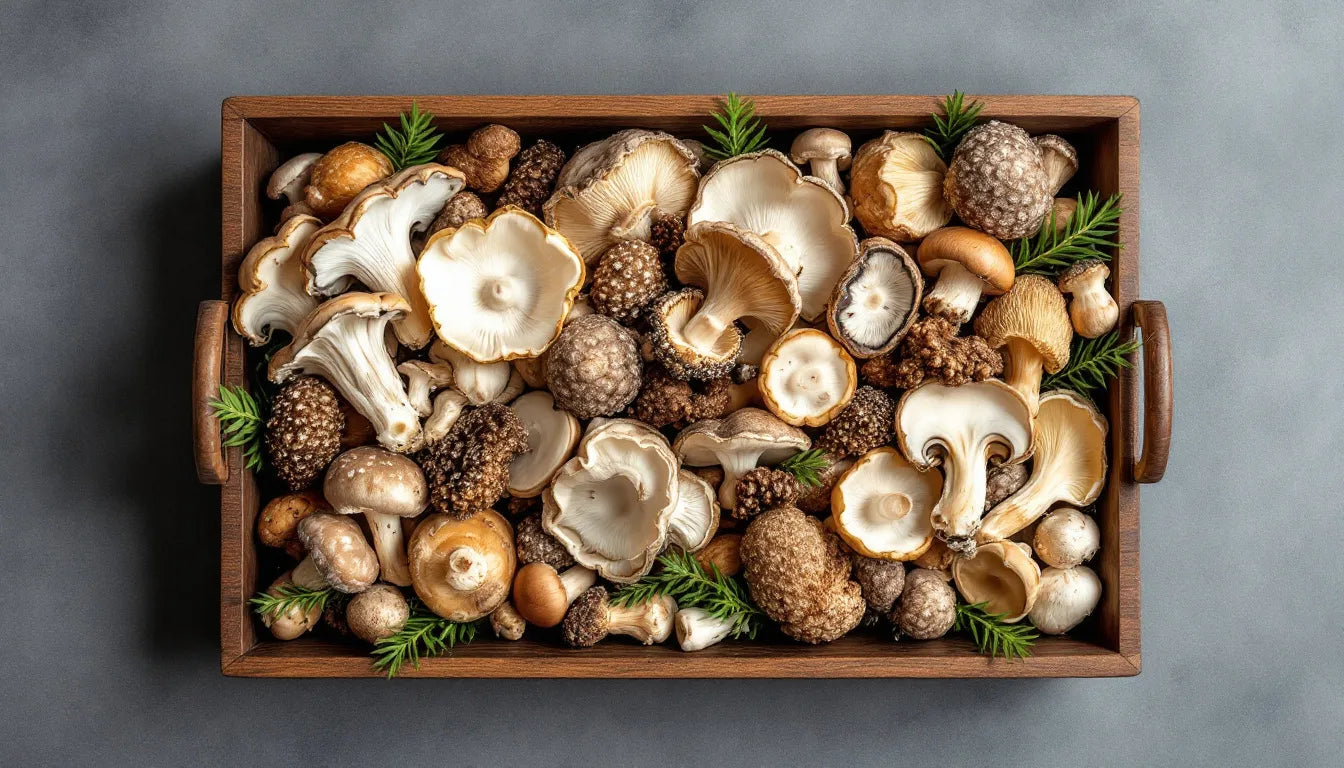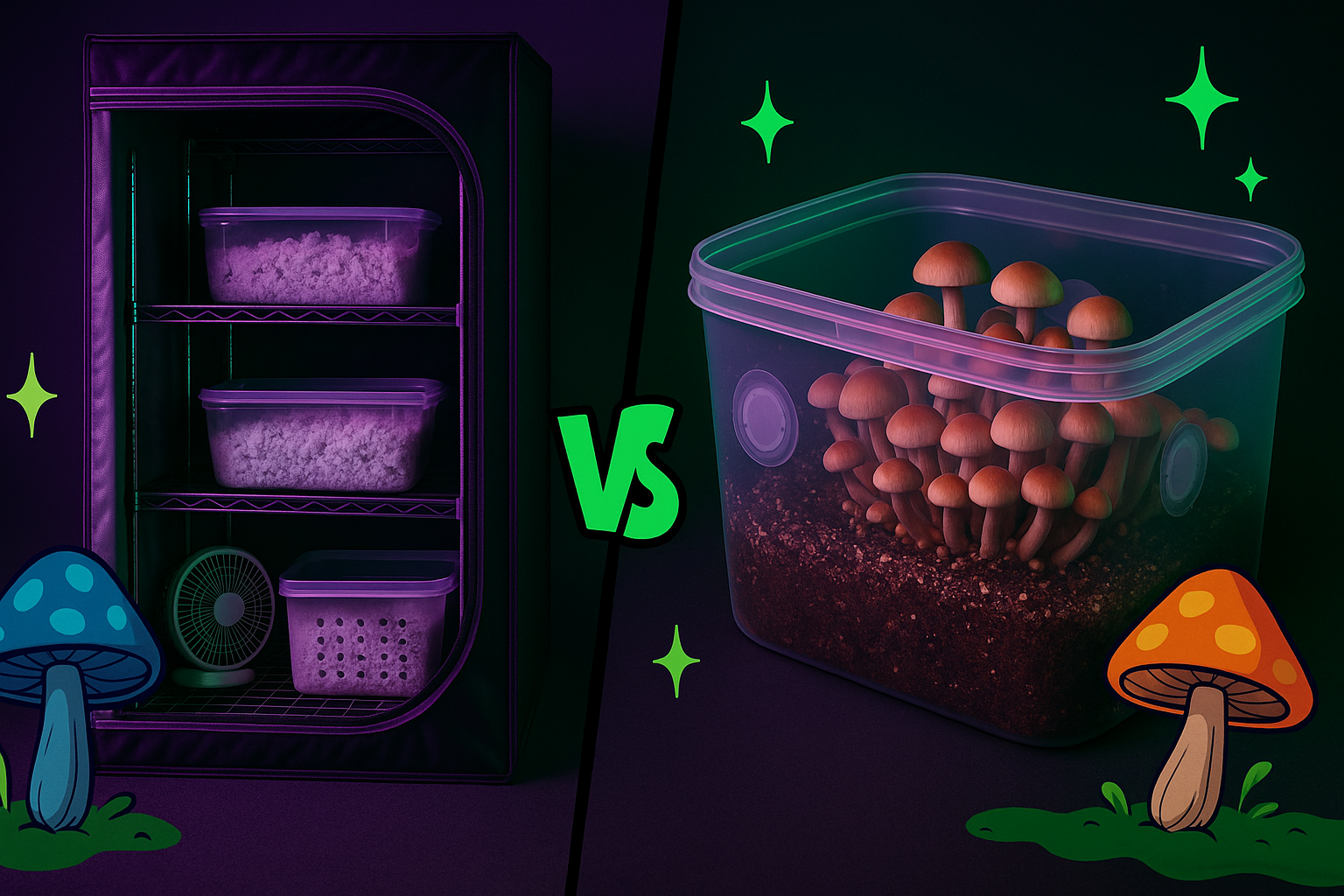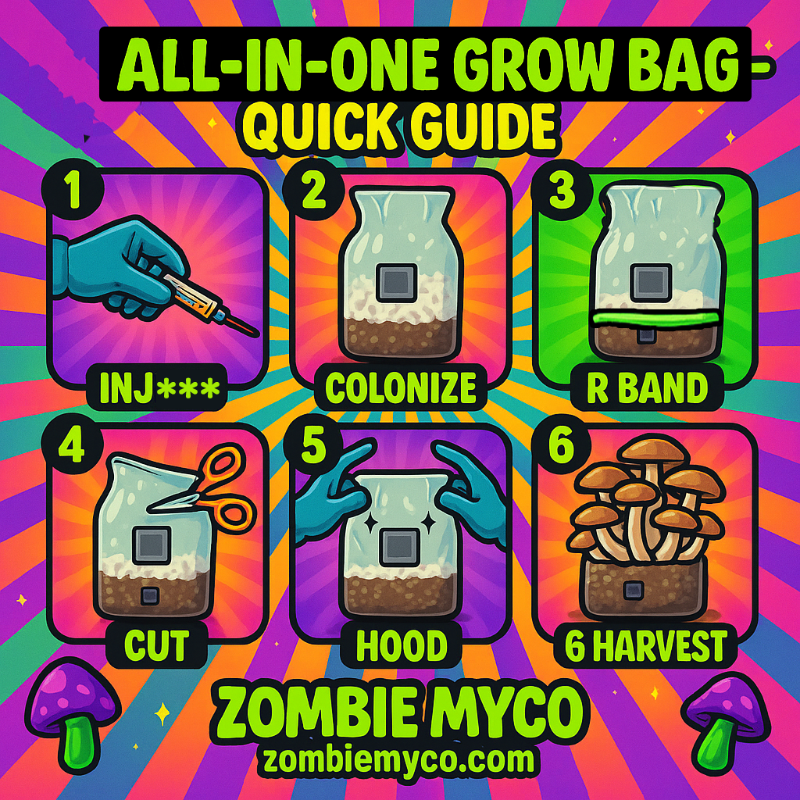- 🍄 Studies show gourmet mushrooms like Lion's Mane grow much better in Martha grow tent environments.
- 💰 Monotub mushroom grow setups cost up to 80% less than Martha tents, a big help for beginners.
- 🌡 Steady conditions in Martha grow tents lowers the chance of contamination in indoor mushroom growing.
- ⚙️ Monotubs, while passive, still require tuning for fae and humidity to prevent yield drop and mold.
- 🧪 Users report over 50% faster growth cycles when using good spawn and substrate kits across both systems.

What Is a Martha Grow Tent?
A Martha grow tent—often called simply a Martha tent—is a compact indoor mushroom growing system adapted from affordable mini-greenhouses. The name comes from early hobbyists who modified Martha Stewart-style greenhouses, but today it refers to any greenhouse-style setup built to provide proper temperature, humidity, and airflow while reducing contamination risks. For beginners or small-space growers, a Martha tent can be an efficient alternative to larger fruiting chambers, and it works especially well alongside mushroom grow bags, which make colonization and fruiting easier to manage in a controlled environment.
Components of a Martha Grow Tent
A Martha grow tent usually has these parts:
- Shelving unit: Multiple wire shelves for stacking trays or bags
- Plastic tent cover: This keeps humidity in and stops contaminants.
- Ultrasonic or cool-mist humidifiers: These keep humidity high (80%–95%).
- Fans or inline duct blowers: These move air and help with fresh air (FAE).
- Timers and hygrometers: These turn misting on and off automatically and check conditions.
- Filters or HEPA inlets: You can add these to lower contamination risk.
Martha grow tents are not like regular indoor greenhouses. They are made for the special needs of mushrooms when they fruit. This lets you grow kinds that need a lot of humidity or are sensitive to CO₂.
Advantages Over Traditional Greenhouses
Ordinary greenhouse tents are for growing plants. But mushrooms fruiting needs much higher humidity, less light, and is more sensitive to CO₂. A Martha tent can help you grow many kinds of mushrooms and get a lot of them in a small space. This makes it great for serious growers.

What Is a Monotub Mushroom Grow Chamber?
Monotub mushroom grow chambers are simple and good setups. They are mostly a plastic tub with special air holes. The design uses natural humidity control and air movement. This creates the right small environment for colonized mycelium to fruit.
Key Features of a Monotub Setup
- Plastic tote: Usually 15–30 gallons. It has a clear or see-through body and lid.
- Air exchange holes: These are drilled near the top and bottom. They are filled with polyfill or covered with micropore tape.
- Sealed lid: This keeps humidity from the substrate inside.
- Bulk substrate: This is a mix of things like coco coir, vermiculite, gypsum, or hardwood sawdust.
- Spawn: This is grain with mushroom mycelium growing on it. You mix it into the substrate.
Monotubs mostly rely on conditions that take care of themselves. These include a steady room temperature (68°F–75°F), wet substrate, and natural airflow from the air around them.
A Passive Approach to Mushroom Growing
Monotubs are very simple. Once you set them up, you usually don't need to do much until harvest. This is why new growers like them. People also like them for strains that can handle different conditions.

Comparing Key Features: Martha Grow Tent vs Monotub
| Feature | Martha Grow Tent | Monotub Mushroom Grow Setup |
|---|---|---|
| Setup Complexity | Medium to High (technical tuning) | Low (easy DIY) |
| Initial Investment | $150–$300+ | $25–$50 |
| Space Efficiency | High (vertical shelving capacity) | Medium (floor/horizontal space only) |
| Strain Flexibility | Suitable for a wide range | Ideal for sturdy strains |
| Humidity Control | Active (humidifiers & automation) | Passive (substrate moisture retention) |
| Fresh Air Exchange | Fan-assisted, timed FAE | Natural (via polyfill holes) |
| Light Requirements | External lights often added | Relies on room ambient lighting |
| Contamination Control | Enhanced by enclosed tent | Moderate (dialed-in tubs reduce risk) |
| Ideal for Scaling | ✅ High-yield expansion possible | 🚫 Limited to 1–2 tubs per space |

Pros and Cons of the Martha Grow Tent
✅ Pros
- You can grow more: With 3–5 shelves, you can handle many kinds or batches at the same time.
- Control over conditions: You can set timers and keep humidity steady. This is great for species that need exact fruiting conditions.
- Good results: If set up right, Martha tents are less likely to get contaminated. This is because of steady airflow and high humidity.
- Good for special mushrooms: Kinds like shiitake, lion’s mane, and enoki grow well in controlled humidity above 85%.
❌ Cons
- Needs power: You need outlets for humidifiers, fans, and lights.
- Costs more to set up: Equipment and parts can cost over $300.
- More work: You must check humidity and air exchange every day.
- Takes up space: It needs its own floor space, usually about 2ft x 4ft.
“Fruiting chambers like the Martha tent allow for better air circulation, consistent humidity, and multiple grow levels, making them good for growing a lot of mushrooms or special kinds.” (Barbee, 2022)

Pros and Cons of the Monotub Mushroom Grow
✅ Pros
- Cheap: You can often build the whole thing for less than $50.
- Good for beginners: It has easy instructions, many guides, and materials that are easy to get.
- Little work: Once it's set up correctly, you don't need to do much until harvest.
- Small: It's small and has few parts, so it fits even in studio apartments or dorm rooms.
❌ Cons
- Conditions can change: How well they grow depends on the air where you live and how wet the substrate is.
- Grow one kind at a time: You usually grow one monotub batch and strain at a time. You would need more tubs to grow more.
- Airflow problems: Bad airflow can cause stroma (weird mycelium) or contamination to grow.
- Fewer ways to stay clean: Compared to a Martha tent, spores can get into the substrate more easily.
“Monotubs are cost-effective and low-maintenance, making them perfect for beginners. They rely on passive air exchange and humidity from the substrate.” (Ruiz, 2022)

Best Mushroom Strains by Setup Type
Mushrooms that like high humidity and exact conditions grow best in Martha tents.
🍱 Martha Grow Tent Favorites
- Lion's Mane (Hericium erinaceus): It is very sensitive to CO₂ and humidity. It grows best in a Martha tent with steady fresh air.
- Shiitake (Lentinula edodes): It needs complex fruiting signals. These include cold periods and a lot of airflow.
- Enoki: It likes cold temperatures and high humidity. It is easy to handle inside a Martha tent.
- Chestnut Mushrooms: They grow a lot of mushrooms when they get the right humidity and light.
- Pink Oyster: It grows fast in humid conditions with good airflow and normal light.
“Certain mushroom species like lion’s mane or shiitake grow best with the very controlled conditions that Martha-style setups give.” (Tran, 2021)
🪣 Top Monotub Mushroom Varieties
These mushrooms grow well in places with changing conditions, so they are good for a monotub.
- Psilocybe cubensis (where legal): This is one of the toughest species. It spreads fast.
- Blue Oyster: It fruits fast and is not very sensitive to CO₂.
- Golden Oyster: It adapts well and is colorful. It is a great species for casual growing.
- King Oyster: It can be hard to grow, but possible if you control moisture.
- Reishi (Ganoderma lucidum): It will grow in monotubs with enough time and if you adjust the moisture.
“Monotubs work best for mushrooms like Psilocybe cubensis and oysters, which can handle less controlled places and still grow well.” (Patel, 2022)

Cost & Space Comparison
Martha Grow Tent
- Estimated Investment: $150–$300+
-
Components Cost Breakdown:
- Shelving rack: $60
- Greenhouse cover: $40
- Humidifier/system: $50–$100
- Timers/fans/monitors: $40
- Footprint: ~2ft x 4ft, vertical use maximizes yield per sq ft
Monotub Mushroom Chamber
- Estimated Total Cost: $25–$50
-
Supplies Breakdown:
- Storage bin: $15
- Polyfill/micropore tape: $8
- Substrates/spawn: $15–$20
- Footprint: Varies by tub, fits on typical shelf or tabletop

Daily Care & Monitoring Differences
| Task | Martha Tent | Monotub |
|---|---|---|
| Humidity Checks | You adjust it all the time. | Self-regulated by substrate |
| Air Exchange | Fan and timer do it automatically. | Passive (polyfill ventilation) |
| Temp Adjustment | You use portable heaters or fans. | Relies on room temp composition |
| Substrate Watering | Almost never. | Often none once spawned |
| Mold Checks | Check every day. | Once a week, or when you open the lid. |
Which Setup Is Right for You?
Ask yourself these questions:
| Decision Criteria | Choose Martha Tent | Choose Monotub |
|---|---|---|
| Do you want to grow special or fancy kinds of mushrooms? | ✅ Yes | |
| On a tight budget? | ✅ Yes | |
| Prefer a tech-free, unplugged grow? | ✅ Yes | |
| Do you need to grow big amounts often? | ✅ Yes | |
| Do you want to try many different kinds? | ✅ Yes | |
| Do you need to grow in a small, tight space? | ✅ Yes |

Zombie Mushrooms Supports Every Grower
If you choose a Martha grow tent or monotub mushroom grow setup, Zombie Mushrooms can help you with:
- ✔️ Grain spawn with mycelium already growing, and liquid cultures
- ✔️ Clean agar plates to grow cultures more
- ✔️ Clean monotub substrate blocks to make spawning easy
- ✔️ All-in-one grow kits that work with Martha or monotub setups
- ✔️ Strong air filtration bags for both early growth and fruiting
Our products help new and experienced mushroom growers. They use materials tested in a lab and give good growth results.

FAQ: Martha Grow Tent vs Monotub
Q1: What exactly is a Martha grow tent?
A Martha grow tent is an indoor mushroom fruiting chamber adapted from compact greenhouse designs. It’s built to control humidity, airflow, and temperature in a vertical fashion, often with shelving for multiple bags or trays.
Q2: How does a monotub differ from a Martha tent?
A monotub is a simple plastic container with filter-holes and passive ventilation. It’s low cost and low maintenance, while Martha grow tents offer more control (humidity, airflow, shelving), but at higher complexity and cost.
Q3: Which setup is more cost-effective for beginners?
Monotubs are generally much cheaper (often under $50) compared to Martha tents, which may require humidifiers, fans, and enclosure materials. Monotubs are perfect for starters wanting minimal complexity.
Q4: Which setup is better for high-value or sensitive strains?
Martha grow tents tend to be better for sensitive or specialty mushrooms (like lion’s mane, shiitake, or strains needing tight climate control) because they allow for more precise regulation of humidity, airflow, and layering.
Q5: Can you scale either setup easily?
Yes. Martha tents allow vertical expansion via shelves and automation (timers, fans). Monotubs are easy to replicate side by side, making them modular and scalable in smaller spaces.
Q6: How do contamination risks compare between the two?
Martha tents, with sealed chambers and environmental controls, can reduce contamination risk if properly maintained. Monotubs rely more on proper setup, substrate quality, and ventilation but can also be kept clean with good hygiene practices
Final Thoughts: Your Next Steps
Choosing between a Martha grow tent vs a monotub mushroom grow setup is all about what makes sense for you—your space, your money, your experience, and what you want to achieve. Both systems have helped thousands of hobby and pro growers get fresh, strong mushrooms indoors.
Start small, keep it clean, and grow more as you get better. And if you’re ever in doubt, Zombie Mushrooms offers cultivation kits, spawn, and substrate solutions to keep your harvest doing well—no matter what setup you have.
Citations
Barbee, G. (2022). “Fruiting chambers like the Martha tent allow for better air circulation, consistent humidity, and multiple grow levels, making them good for growing a lot of mushrooms or special kinds.”
Ruiz, L. (2022). “Monotubs are cost-effective and low-maintenance, making them perfect for beginners. They rely on passive air exchange and humidity from the substrate.”
Tran, H. (2021). “Certain mushroom species like lion’s mane or shiitake grow best with the very controlled conditions that Martha-style setups give.”
Patel, J. (2022). “Monotubs work best for mushrooms like Psilocybe cubensis and oysters, which can handle less controlled places and still grow well.”



